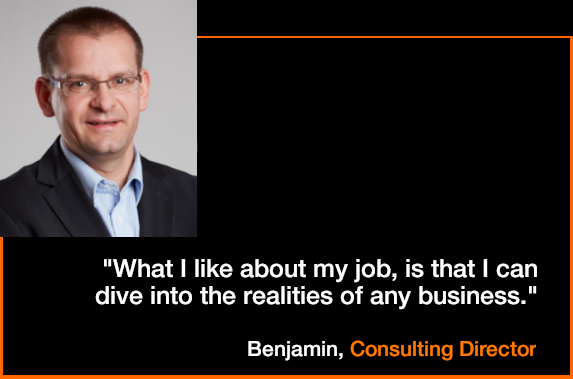Benjamin’s ta-da story: data creates a powerful link between the brand and its customers

The expertise of those who work for our company and their diverse professional backgrounds is the main reason why Orange Business is so resourceful. The wide skill set of our employees is what enables us to meet the expectations of our customers, right when they need it the most. We like to call it the “ta-da!” effect.
With data, I can dive into the realities of business
"I discovered data through my training as an engineer in information systems management. I was immediately enamoured with the topic because it's business oriented and dives into the realities of different businesses. I was immediately drawn to the way it spans many complex notions that need to be explained in layman’s terms.
"After my first experience at Business & Decision, I joined the IT Department at an affiliate of a major French cosmetics group, where I supported their digital transformation for 10 years. That’s where I learned how to do the job I have today. As a Consulting Director, I guide businesses in their transformation towards a data-centric model."
Digital transformation is, above all, a cultural shift
"Helping a business become data-centric involves three major steps. First, it requires putting in place an architecture that can centralize all the data collected by various platforms. Next comes data governance, which involves updating the organization of the business to focus on data. This step is essential for having access to quality data. The last step is to determine how to capitalize on this data in order to improve the business model. It doesn’t happen all in one day. It’s a long process that demands a thorough transformation and a data culture adopted at every level."
In digital transformation, they keyword is transformation, but businesses are not always aware of this fact.
"Architecture, governance, security: from early consulting to the technical rollout, we support our customers throughout their entire data-centric transformation. Let’s take the example of a luxury watch brand that turned to us to carry out its digital transformation. They didn’t really know where to begin. All they knew is that they had a massive volume of customer data, which is a vital business asset. We helped the brand ask the right questions to shift towards a data-centric model. I must underline that this was not an easy task for a prestigious brand focused on high-end craftsmanship and know how."
A digital transformation on three levels: employee, customer and product
"For this reason, we launched three major initiatives. The first aimed to transform the employee experience by pivoting from an all-in-person approach to management based on targets, notably using collaborative tools. The next sought to improve the end-customer experience by enabling them to interact with the brand across various digital channels. Finally, we put in place a system to improve product traceability and associate each watch with its buyer using blockchain. The company can now collect customer data during every interaction with the brand."
The ta-da effect: creating an amazing relationship with consumers
"By harnessing the power of data, the brand pushed the personalization of its customer relationships to a new level. Whenever a customer enters the store, the brand has access to all of the customer’s information, including their purchase history, personal preferences and possible expectations. The brand can also send them the right information at the right time via email or SMS.
"Moreover, the data processing tools we set up also offer benefits to employees. For example, they can now focus on high-value data analysis tasks. This is a major improvement, because the hidden costs tied to correcting data can represent up to 15-30% of a company’s revenue."


